Irish archaeologists are confused by the “bizarre” discovery of a 1,150-year-old Viking necklace in a cave in the Burren.
Besides being the largest by far – up to 12 times longer than previous finds – the team is confused by how such a “high-status” Viking treasure came to lie in the Burren, an area never settled by the Norsemen.
Besides being the largest by far – up to 12 times longer than previous finds – the team is confused by how such a “high-status” Viking treasure came to lie in the Burren, an area never settled by the Norsemen.
The site where the necklace was found at Glencurran Cave was explained by team leader Dr Marion Dowd of Sligo IT as a “treasure trove” for archaeologists.
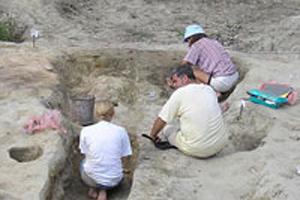
The necklace is one of a number of most important items discovered in the dig, funded by the Department of the Environment and the Royal Irish Academy.
Dr Dowd said “The necklace is the largest Viking necklace to have been found in Ireland. Usually, Vikings necklaces that have been found have five to six glass beads, but this has 71 glass beads covered with gold foil.”
A leading expert on Irish cave archaeology, Dr Dowd was confused by how such a “stunning piece of jewellery” came to rest in the Burren.
“There is no parallel for it in Ireland and it is perplexing on a number of fronts,” he said.
Dr Dowd said that the Vikings never settled in the Burren, but that couplet was one of the Irish cities that they did settle in and wondered that the necklace – dating from the mid 9th century – could have been the result of a trade with Vikings from Limerick and Gaelic chieftains in the Burren.
Already, the skeletal remains of a two to four-year-old child that were placed in the cave in the Bronze Age, about 3,500 years ago, were subject to ancient DNA analysis.
In all, the dig has discovered the remains of seven adults, two children and one baby. A 10,000-year-old bear shoulder bone, a scapula, has also been found.
This article appeared in the printed version of the Irish Examiner Wednesday, April 28, 2010
An ‘alternative’ archaeological tour of Jerusalem
Yonathan is one of the founding members of Emek Shaveh, a non-profit organization composed of archaeologists, Silwan residents and human rights activists, which aims to “hut light on the vital role of archaeology in the Israeli-Palestinian quarrel.” Yonathan worked as an archaeologist for the Israel Antiquities Authority (IAA) for many years. Sent to work in East Jerusalem he witnessed firsthand the collusion of government, academic institutions and Israeli interest groups in utilizing archeology for political purposes.
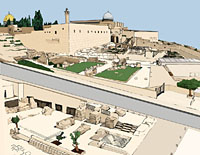
The City of David archaeological site lies in East Jerusalem, which Palestinians and the international community define as occupied country. Stretching down from the Dung Gate of the Old City, the site bisects the village of Silwan – splicing the Palestinian district in two. Although its presumed historical significance not to mention its illegality under international law, Israel allows the site to be the country’s only privately owned and administered “national” park. Israel has chosen for this role the Elad Association, an Israeli organization that funds Jewish settlement in East Jerusalem. The Israel Antiquities Authority helps to legitimize Elad’s activities and particular vision of history by monitoring the excavations on its behalf. Elad also enjoys the support of both the Israeli Prime Minister’s office and the Jerusalem Municipality.
The archaeological digging has destabilized the structure of many buildings in Silwan, cracks have opened up in floors and walls, and gaping holes have appeared in Silwan’s streets after heavy rainfall. 88 Palestinian homes have been given destruction notices in order to build the “archaeological park.” Elad has little incentive to respect the rights of those living on or near the site.
In the blessed land today it is impossible to separate archaeology from politics. Archaeology is used in the battle over differing narratives. Yonathan attempts to explain Elad’s logic: “If the past can be proven to belong to ‘us’ then the present and future should be ‘ours’.” In the quest to suitable more land, the building of tourist parks and the expansion of archaeological sites is presented as an academic and thus innocent activity. Yonathan wonders how the scientists, archaeologists working at the dig, can separate themselves from the apparently inherent political ramifications of their work considering their surroundings.
During recent tensions resulting from the government announcement of more settlements in East Jerusalem, aggravation and anger were taken out on a guard post at the exit of the tourist site. The little metal box that once contained Israeli armed security personnel has been burnt to a brittle. The guns were not there to protect local residents, but rather to protect settlers and tourists from these residents. The ‘alternative’ tourists on our archaeological tour gape and wonder at the charred wood as we make our way out of the City of David and onto the residential streets that may be bulldozed someday soon.
A newly discovered Temple to render traces of Indonesia’s past
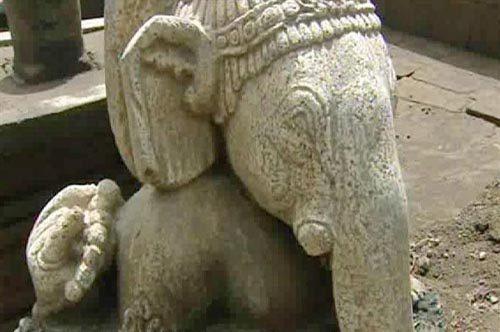
Archaeologists in Indonesia have revealed a 1,000-year-old temple that could provide more information on the country’s Hindu past.
The intricately engraved statues and reliefs are some of the best conserved in Indonesia, but the dig is being carried out under tight security to shield the site from well-organized artifact thieves.
The temple was found on the base of Yogyakarta’s Islamic University as workers explored the ground to lay foundations for a new library, and they realized the earth below their feet was not stable.
Digging soon revealed a strange find: three meters underground were still-standing temple walls. Heavy rains then uncovered the top of a statue of the god Ganesha in immaculate condition.
After a few weeks into the excavation, the archaeologists have stated that the temple and its exceptional and beautiful statues a significant discovery that could provide insight into Indonesia’s pre-Islamic culture.
“This temple is a quite significant and very valuable because we have never found a temple as whole and intact as this one,” said archaeologist Dr Budhy Sancoyo, who is one of the researchers painstakingly cleaning up the temple.
“For example, looking at where the statues are placed in this temple, they are in their original positions, unlike the other temples.
“This temple is important for understanding the culture of our ancestors.”
The Tomb Of legendary general Cao Cao discoved by archaeologists In central China
The tomb of a well-known warlord and politician in the third century, Cao Cao was discovered in Anyang City of central China’s Henan region, said the archaeologists on Sunday.
Cao Cao (155-220 A.D.), who built the strongest and most victorious state during the Three Kingdom period (208-280 A.D.), is remembered for his terrific military and political talents.
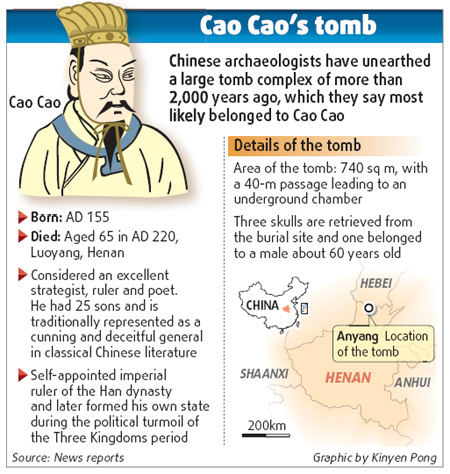
Cao Cao is also recognized for his poems that reflected his strong nature. Some of the poems are integrated in China’s middle school textbooks.
Three ancient carcasses, one man and two women, were found in the two-chamber tomb in Xigaoxue village of Anyang. Cao Cao died in his sixties, this coincides age the of the man that was found, Liu Qingzhu, chief of the academic committee of Chinese Academy of Social Sciences, told a press conference in Beijing.
More than 250 objects, made of gold, silver, pottery and etc, were revealed from the 740-square-meter tomb, a size apposite for a king. Archaeologists also revealed 59 engraved stone plates logging the name and amount of the articles obscured in the tomb. Seven of the plates logged weapons “often used by the king of Wei”, or Cao Cao, Liu said.
They had also discovered a large number of paintings drawn on stone plates, Liu added.
“Cao Cao wrote in his will that his burial place should be simple, which corresponds to the fact that the walls of the tome were not painted and few precious articles were found”, said Hao Benxing, head of Henan’s Institute of Archaeology.
“The position of the tomb is in line with historical recordings and ancient books from Cao Cao’s time”, Hao added.
Even though additional excavations are yet to be carried out, present proofs are enough to prove this is Cao Cao’s tomb, said Guan Qiang, director of the archaeology department of China’s State Administration of Cultural Heritage.
Part of a pylon of the Isis temple discovered by Underwater Achaeologists
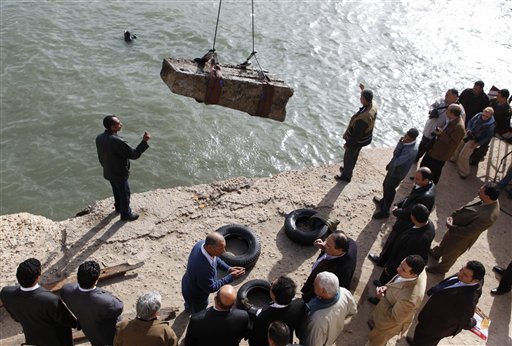
Egyptian archaeologists have lifted an ancient granite temple pylon out of the waters of the Mediterranean, where it had been lying for about centuries as part of the palace complex of Cleopatra, submerged in Alexandria’s harbor.
The pylon, which previously stood at the entrance to a temple of Isis, is to be the showpiece of an ambitious underwater museum planned by Egypt to display the sunken city, which is supposed to have been collapsed into the sea by earthquakes in the 4th century.
Divers and underwater archaeologists used a huge crane and ropes to haul up the 9-ton, 7.4-foot-tall pylon, covered with dirt and seaweed, out of the muddy waters. It was placed on shore as Egypt’s top archaeologist Zahi Hawass and other officials observed.
The temple, devoted to Isis, a pharaonic goddess of fertility and magic, is at least 2,050 years old, but likely much older, and the pylon was cut from a single slab of red granite excavated in Aswan, some 700 miles to the south, officials said. It was part of a rambling palace from which the Ptolemaic dynasty ruled Egypt and where 1st Century B.C. Queen Cleopatra persuaded the Roman general Marc Antony before they both committed suicide following their defeat by Augustus Caesar.
Egyptian authorities hope that ultimately it will turn out to be a part of the underwater museum, an ambitious effort to draw tourists to the country’s northern coast, often outshined by the grand pharaonic temples of Luxor in the south, the Giza pyramids outside Cairo and the beaches of the Red Sea.
Still in its developing stages, the museum would permit visitors to saunter through underwater tunnels for close-up views of sunken artifacts, and it may even comprise a submarine on rails.